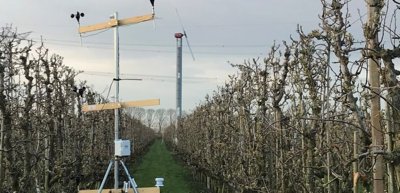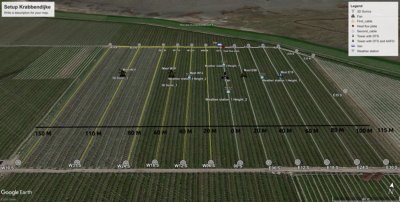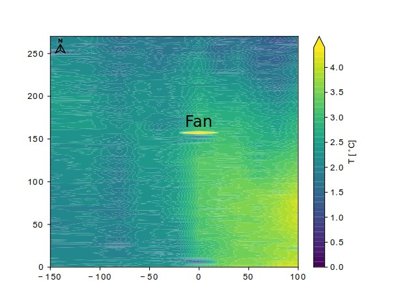Early spring can be a stressful period for fruit and wine growers due to potential night frost. The FruitFrost project seeks to reduce the pressure on farmers through the development of an automated sensor network and finding energy-saving methods to fight the frost. Computer modeling is used to ensure optimal methods such as the suitable setting of wind machines. Eventually, the aim is to provide farmers with a real-time, 3D beeld image of the ‘frost front’ in the orchard, to enable them to directly take effective measures.
Farmer stress
All efforts of cultivation and expectations of the harvest may end in vain due to a single cold night. To prevent these devastating losses, farmers often stay up all night keeping an eye on air temperatures and worrying whether it is necessary to use the expensive protective measures such as wind machines or paraffin pots. Starting too early or too late is not only a waste of money, but can also have the opposite effect; increasing frost damages.
More about the research
What is this Fruitfrost team researching to combat the frost? The aim is to understand the temperature and plant response to frost mitigation measures such as wind machines through a combination of outdoor experiments and computer modeling. At the same time, a low-cost, automated sensor network will be developed for real-time monitoring of the field. With the combination of an effective mitigation method and a real-time alarm system, the grower can effectively and efficiently protect the trees.
In the first year of the project the team focus on better understanding of how operation of wind machines benefit plants during cold nights. During a calm, cloudless night in spring, the air surrounding the fruit trees can drop below zero degrees through radiative cooling. This results in an inversion layer: a temperature increase with height close to the ground. The air above the inversion layer is warmer. Wind machines can be used to mix this warm air down to the surface. On top of that, the extra wind improves the heat exchange between the plant and the, now relatively warm, air. Although implementation of these measures require large investments, surprisingly little is understood about their effectiveness and the underlying physical mechanisms. The extent of the protected area depends on the management of the wind machine, such as the rotation speed, and angle relative to the ground. In order to see how these factors influence the air temperature and plants' response, the outdoor experiment and computer modeling come into play.

During the spring of 2021, the Fruitfrost team from TU Delft has been busy with a field campaign at a pear orchard in Krabbendijke (Zeeland). A grid of fiber optic cables with a total length of 9 kilometers covers around 4 hectares of orchard and measures temperatures at two heights.
Photo: the fan, weather station and fiber optic cables
 In addition, a couple of 9 m high towers are used to determine the vertical temperature profiles. By combining this with thermal images of the trees and wind measurements, the researchers can study the effect of the wind machine on the air and tree temperatures through the entire orchard.
In addition, a couple of 9 m high towers are used to determine the vertical temperature profiles. By combining this with thermal images of the trees and wind measurements, the researchers can study the effect of the wind machine on the air and tree temperatures through the entire orchard.
Photo: setup of the experiment
 The preliminary results show the temperature enhancement in 2D duo to operation of the wind machines. Hourly average temperature from 1AM to 2AM is shown. Let’s see how many more plants can be protected with the optimized wind machine setup and automated sensor system!
The preliminary results show the temperature enhancement in 2D duo to operation of the wind machines. Hourly average temperature from 1AM to 2AM is shown. Let’s see how many more plants can be protected with the optimized wind machine setup and automated sensor system!
Team
PhD students
Yi Dai MSc: Y.Dai-1@tudelft.nl
Judith Boekee MSc: j.boekee@tudelft.nl
Mustafa Becermis MSc: m.becermis@tudelft.nl
Supervisors
Prof.dr.ir. B.J.H. (Bas) van de Wiel: b.j.h.vandewiel@tudelft.nl
Dr. Ir. Marie-Claire ten Veldhuis: j.a.e.tenVeldhuis@tudelft.nl
Prof.dr. K.A.A. Makinwa k.a.a.makinwa@tudelft.nl
Ir. Bart Schilperoort: b.schilperoort@tudelft.nl
Dr. Qinwen Fan: q.fan@tudelft.nl



